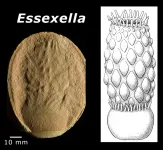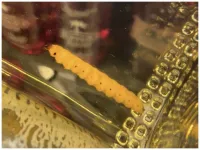(Press-News.org) The nitrate ingested over the course of a person’s adult lifetime through the consumption of tap water and bottled water could be a risk factor for prostate cancer, particularly in the case of aggressive tumours and in younger men. This is the conclusion of a study conducted in Spain and led by the Barcelona Institute for Global Health (ISGlobal), a centre supported by the ”la Caixa” Foundation. The findings have been published in Environmental Health Perspectives.
The study also suggests that diet plays an important role. The researchers found that eating plenty of fibre, fruit/vegetables and vitamin C could reduce the negative effect of nitrate in drinking water.
Ingestion of Waterborne Nitrate and Trihalomethanes
The aim of the study was to assess whether there was an association between the ingestion of waterborne nitrate and trihalomethanes (THMs) and the risk of prostate cancer. Nitrate and THMs are two of the most common contaminants in drinking water. The nitrate present in the water comes from agricultural fertilisers and manure from intensive livestock farming; it is washed into aquifers and rivers by rainfall. “Nitrate is a compound that is a part of nature, but we have altered its natural cycle,” explained Cristina Villanueva, an ISGlobal researcher specialised in water pollution. The new study looked at whether long-term exposure to nitrite throughout adulthood could lead to cancer.
THMs are by-products of water disinfection—i.e. chemical compounds formed after drinking water is disinfected, usually with chlorine. Unlike nitrate, for which the only route of entry is ingestion, THMs can also be inhaled and absorbed through the skin while showering, swimming in pools or washing dishes. Long-term exposure to THMs has been associated with an increased risk of bladder cancer, but evidence of the relationship between THMs and other types of cancer is, to date, very limited.
Prostate Cancer and Long-Term Exposure to Nitrate and THMs in Drinking Water
To evaluate the possible association between prostate cancer and long-term exposure to nitrate and THMs in drinking water, a research team led by ISGlobal studied 697 cases of prostate cancer in Spanish hospitals between 2008 and 2013 (including 97 aggressive tumours), as well as a control group made up of 927 men aged 38-85 years who had not been diagnosed with cancer at the time of the study. The average nitrate and trihalomethanes to which each participant had been exposed since the age of 18 was estimated based on where they had lived and the type (tap water, bottled water or, in some cases, well water) and amount of water they had drunk throughout their lives. Estimates were made on the basis of available data from drinking water controls carried out by municipalities or concessionary companies, from analyses of bottled water of the most widely distributed brands, and from measurements taken in different Spanish locations supplied by groundwater.
The findings showed that the higher the nitrate intake, the greater the association with prostate cancer. Participants with higher waterborne nitrate ingestion (lifetime average of more than 14 mg per day) were 1.6 times more likely to develop low-grade or medium-grade prostate cancer and nearly 3 times more likely to develop an aggressive prostate tumour than participants with lower nitrate intakes (lifetime average of less than 6 mg per day).
“It has been suggested that aggressive prostate cancers, which are associated with a worse prognosis, have different underlying aetiological causes than slow-growing tumours with an indolent course, and our findings confirm this possibility,” explained ISGlobal researcher Carolina Donat-Vargas, lead author of the study. “The risks associated with waterborne nitrate ingestion are already observed in people who consume water with nitrate levels below the maximum level allowed by European directives, which is 50 mg of nitrate per litre of water.”
Drinking Water Does Not Imply Getting Cancer
The authors noted that this study simply provides the first evidence of the association, which will need to be confirmed through further research. Therefore, there is still a long way to go before we can assert a causal relationship. “Being exposed to nitrates through drinking water does not mean that you are going to develop prostate cancer,” commented Donat-Vargas. “Our hope is that this study, and others, will encourage a review of the levels of nitrate that are allowed in water, in order to ensure that there is no risk to human health.”
While the ingestion of waterborne THMs was not associated with prostate cancer, THM concentrations in residential tap water were associated with the development of these tumours, suggesting that inhalation and dermal exposure may play a significant role in total exposure. Further studies properly quantifying exposure to THMs via multiple routes are needed to draw firm conclusions.
Fibre, Fruit, Vegetables and Vitamin C to Prevent Prostate Cancer
Participants also completed a food frequency questionnaire, which provided individual dietary information. A striking finding of the study was that the association between ingested nitrate and prostate cancer were only observed in men with lower intakes of fibre, fruit/vegetables and vitamin C. “Antioxidants, vitamins and polyphenols in fruits and vegetables may inhibit the formation of nitrosamines—compounds with carcinogenic potential—in the stomach,” explained Donat-Vargas. “Moreover, vitamin C has shown significant anti-tumour activity. And fibre, for its part, benefits the intestinal bacteria, which protect against food-derived toxicants, including nitrosamines.” In participants with lower intakes of fibre (≤11 g/day), higher nitrate intake increased the likelihood of prostate cancer by a factor of 2.3. However, in those with higher intakes of fibre (>11 g/day), higher nitrate intake was not associated with an increased likelihood of prostate cancer.
The research team hopes that this study will help to raise awareness of the potential environmental and human health impacts of pollutants in water, and to persuade authorities to ensure more rigorous control of this natural resource. Among the measures proposed by the authors of the study to reduce nitrate levels are "putting an end to the indiscriminate use of fertilisers and pesticides", and encouraging the adoption of diets that prioritise the health of the planet by reducing the consumption of animal-based foods, especially meat.
Prostate Cancer: The Most Common Cancer in Spanish Men
Prostate cancer appears to be on the rise worldwide. It is currently the most common cancer in Spanish men, among whom it accounts for 22% of all tumours diagnosed. However, its causes remain largely unknown, and it is one of the few cancers for which the International Agency for Research on Cancer (IARC) has not identified a clear carcinogenic agent. The currently recognised risk factors—age, ethnicity and family history—are non-modifiable. However, it is suspected that certain environmental exposures may contribute to the development of prostate cancer, especially in its advanced-stage and more aggressive forms. Therefore, it is vitally important to continue exploring the environmental factors that may contribute to the development of this cancer, so that action can be taken to prevent it.
END
Long-term exposure to nitrate in drinking water may be a risk factor for prostate cancer
Nitrate is present in tap water and bottled water, largely due to the use of fertiliser in agriculture and the manure produced by intensive livestock farming
2023-03-08
ELSE PRESS RELEASES FROM THIS DATE:
UNIST receives generous gift from BNK Kyongnam Bank
2023-03-08
UNIST and BNK Kyongnam Bank recently held a donation agreement ceremony in pursuit of creating a beautiful, biodiverse, and sustainable kitchen garden on UNIST campus.
A ceremony to commemorate and display gratitude for BNK Kyongnam Bank also took place on Friday, February 24, 2023. As part of its Carbon Neutral Campus Project, UNIST has been implementing a number of projects to improve sustainability on campus and in the surrounding community, including the creation of an ecological garden that ...
Seeking leukemia’s Achilles heel
2023-03-08
A team of researchers has discovered a potential therapeutic that can synergize with existing drugs to more effectively kill certain leukemia cells. The authors published their results on Jan. 19 in the journal Molecular & Cellular Proteomics.
Acute myeloid leukemia is a cancer of developing immune cells. It can manifest in all individuals, including the elderly and children. Only 30% of patients survive beyond five years of diagnosis
Unlike cancers of solid organs, AML is found in bodily fluids, such as blood. Like passengers ...
Men over 65 are at greater risk than women of skull fractures from falls
2023-03-08
Each year, more than 3 million people ages 65 and older are treated in emergency departments for fall injuries. Head trauma is the leading cause of serious injury with skull fractures being reported as a serious outcome. According to the 2016 National Trauma Database annual report, females account for 58 percent of these falls.
Because geriatric females have an increased rate of falls and facial fractures, determining if they also are at an increased risk of skull fractures is crucial. Currently, research ...
Highlight facts or appeal to feelings? The psychology of persuading individuals to contribute to a collective goal
2023-03-08
Researchers from Fudan University, China Europe International Business School, and Peking University published a new Journal of Marketing article that examines how marketers can use different messaging to persuade individuals to contribute to a collective goal. The study addresses the specific question of the type of message—fact-based vs. affected-based—that is more effective in eliciting participation based on how near the goal is to completion.
The study, forthcoming in the Journal ...
Just add water: How diluting ouzo liquor could lead to better emulsions
2023-03-08
It sounds like a party trick: Add water to the clear, licorice-flavored ouzo liquor, and watch it turn cloudy. This “ouzo effect” is an example of an easy way to make highly stable emulsions — or mixtures of liquids that don’t like being together, like vinaigrettes — but nobody has yet fully understood how it works. Now, researchers report in ACS Central Science that the secret may lie in the unique structure of the emulsion’s droplets.
Ouzo is a popular liquor enjoyed throughout Greece, ...
Paving a smoother path to manuscript publication
2023-03-08
Shane Harper, DMS, PA-C, knows how difficult it is to launch a medical research journal and get it into the orbit of the scientific community. In 2022 he became the founding editor-in-chief for the West Texas Journal of Medicine, which published its inaugural issue in December.
By establishing a medical research publication, Harper and the journal’s editorial board seek to provide an online publication that distributes original medical and health sciences-related research in a forum free of common predatory publication practices to ...
Paleontologists flip the script on anemone fossils
2023-03-08
Billions of sea anemones adorn the bottom of the Earth’s oceans — yet they are among the rarest of fossils because their squishy bodies lack easily fossilized hard parts. Now a team of paleontologists has discovered that countless sea anemone fossils have been hiding in plain sight for nearly 50 years.
In a newly published paper in the journal Papers in Palaeontology, University of Illinois Chicago’s Roy Plotnick and colleagues report that fossils long-interpreted ...
Mezcal worm in a bottle: DNA evidence suggests a single moth species
2023-03-08
A new study published in PeerJ Life & Environment looked to identify the species of larva found in bottles of Mezcal. Mezcal is a distilled alcoholic beverage made from any type of agave.
Are people consuming larvae of the skipper butterfly Aegiale hesperiaris, or the larva of the moth Comadia redtenbacheri, the latter which is thought to be declining in numbers in recent years? Or is the worm the larva of a weevil, or another unidentified insect species? Researchers used DNA-based identification analysis of larvae inside 21 commercially ...
New device for lower extremity rehabilitation receives FDA approval!
2023-03-08
COTRAS Co., Ltd. (hereon referred to as COTRAS), an innovative medical-device firm focused on rehabilitation products, has secured approval from the U.S. Food and Drug Administration (FDA) for MOBILISE, a medical device to help degenerative knee arthritis patients.
MOBILISE has been promoted among UNIST (Professor Sang Hoon Kang), COTRAS Co., Ltd. (hereon referred to as COTRAS), Korea Institute of Science and Technology (KIST), and Seoul National University Bundang Hospital (SNUH). The aim is to further develop the original technology created by UNIST ...
First nasal monoclonal antibody treatment for COVID-19 shows promise for treating virus, other diseases
2023-03-08
In a pilot trial and clinical sample-based investigations, the drug Foralumab decreased inflammatory markers in patients with COVID-19
Similar reduction in inflammatory markers were seen when given to patients with multiple sclerosis
A pilot trial by investigators from Brigham and Women’s Hospital, a founding member of the Mass General Brigham healthcare system, tested the nasal administration of the drug Foralumab, an anti-CD3 monoclonal antibody. Investigators found evidence that the drug dampened the inflammatory T cell response and decreased lung inflammation in patients with COVID-19. Further analysis showed the same gene expression modulation in patients ...
LAST 30 PRESS RELEASES:
Scientists to ‘spy’ on cancer- immune cell interactions using quantum technology breakthrough
Tech savvy users have most digital concerns
Making lighter work of calculating fluid and heat flow
Normalizing blood sugar can halve heart attack risk
Lowering blood sugar cuts heart attack risk in people with prediabetes
Study links genetic variants to risk of blinding eye disease in premature infants
Non-opioid ‘pain sponge’ therapy halts cartilage degeneration and relieves chronic pain
AI can pick up cultural values by mimicking how kids learn
China’s ecological redlines offer fast track to 30 x 30 global conservation goal
Invisible indoor threats: emerging household contaminants and their growing risks to human health
Adding antibody treatment to chemo boosts outcomes for children with rare cancer
Germline pathogenic variants among women without a history of breast cancer
Tanning beds triple melanoma risk, potentially causing broad DNA damage
Unique bond identified as key to viral infection speed
Indoor tanning makes youthful skin much older on a genetic level
Mouse model sheds new light on the causes and potential solutions to human GI problems linked to muscular dystrophy
The Journal of Nuclear Medicine ahead-of-print tip sheet: December 12, 2025
Smarter tools for peering into the microscopic world
Applications open for funding to conduct research in the Kinsey Institute archives
Global measure underestimates the severity of food insecurity
Child survivors of critical illness are missing out on timely follow up care
Risk-based vs annual breast cancer screening / the WISDOM randomized clinical trial
University of Toronto launches Electric Vehicle Innovation Ontario to accelerate advanced EV technologies and build Canada’s innovation advantage
Early relapse predicts poor outcomes in aggressive blood cancer
American College of Lifestyle Medicine applauds two CMS models aligned with lifestyle medicine practice and reimbursement
Clinical trial finds cannabis use not a barrier to quitting nicotine vaping
Supplemental nutrition assistance program policies and food insecurity
Switching immune cells to “night mode” could limit damage after a heart attack, study suggests
URI-based Global RIghts Project report spotlights continued troubling trends in worldwide inhumane treatment
Neutrophils are less aggressive at night, explaining why nighttime heart attacks cause less damage than daytime events
[Press-News.org] Long-term exposure to nitrate in drinking water may be a risk factor for prostate cancerNitrate is present in tap water and bottled water, largely due to the use of fertiliser in agriculture and the manure produced by intensive livestock farming





